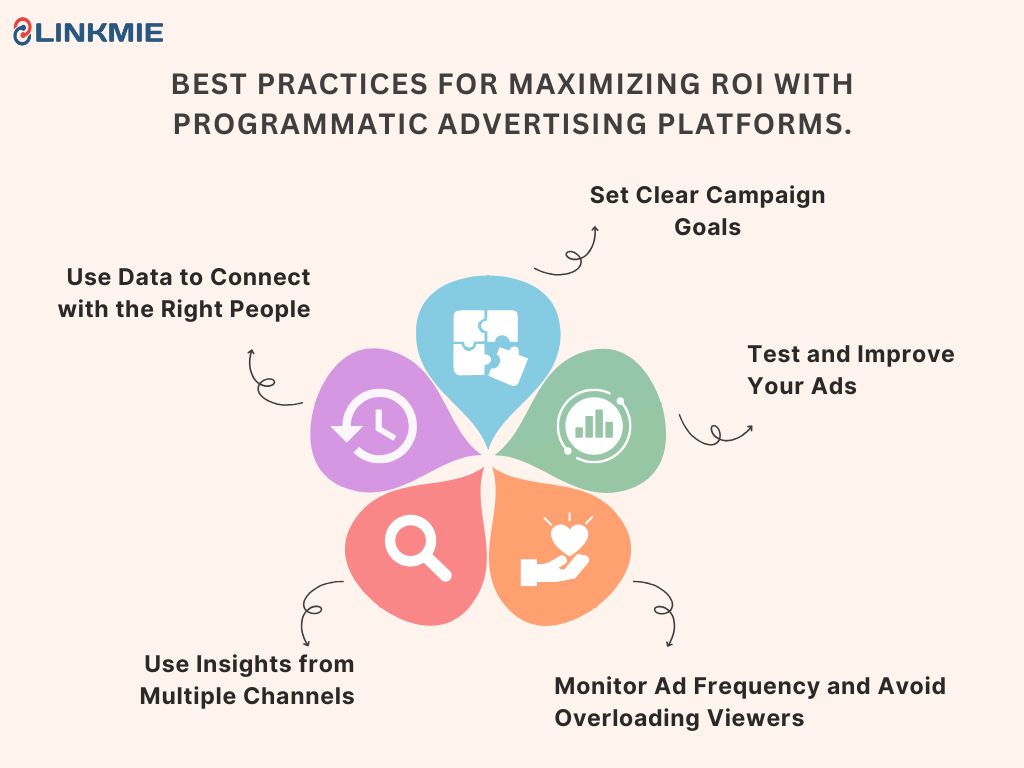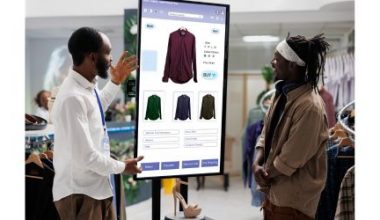Keeping up with digital marketing can be challenging, but programmatic advertising platforms make it more accessible. It automates the process of buying ads so your ads reach the right people at the right time. This helps you get better results and improve your campaign performance.
A few years ago, I faced a tough challenge that changed how I thought about digital advertising. I was running a growing business, managing a lot at once, and needed a way to expand my ad campaigns without spending all my time doing things manually. The old way of buying ads felt slow and exhausting. Then I discovered programmatic advertising, and it completely changed everything for me.
The process uses multiple platforms to digitalise everything, so advertisers don’t have to place orders manually. Instead, they can purchase ad space based on user behaviour or relevant content.
But how can businesses use programmatic advertising to boost their return on investment (ROI)? Let’s explore the best platforms, benefits, and best practices for maximising ROI with programmatic advertising platforms.
Key Points:
- Definition of Programmatic Advertising
Programmatic advertising automates the process of buying and placing digital ads using software and algorithms, enabling precise targeting through real-time bidding (RTB). - Core Benefit
By leveraging user data, programmatic platforms enhance personalization, efficiency, and cost-effectiveness in ad campaigns. - Top Programmatic Platforms
Platforms like The Trade Desk, Google Ads, MediaMath, Amazon DSP, PubMatic, and others are leading tools that facilitate automated ad buying and better ROI. - Best Practices for ROI
Set measurable goals, conduct A/B testing, control ad frequency, and use multi-channel insights to improve ad performance and reach. - Small Business Accessibility
While some platforms may be complex, many offer features and pricing structures suitable for small businesses looking to scale their advertising.
What Is Programmatic Advertising?
Programmatic advertising is a way of automatically buying and placing digital ads using software and algorithms. Instead of negotiating ad spots like traditional advertising, programmatic platforms use real-time bidding (RTB) to purchase ad space on websites, apps, and social media. This speeds up the process and helps advertisers reach the right people more accurately.
At its core, programmatic advertising relies on data to make smarter choices. It examines user behaviour, demographics, and browsing habits, allowing advertisers to create ads that better fit their audience. This makes the process more personalized, efficient, and cost-effective.
I still remember running my first campaign with programmatic tools. It was exciting to see the ads reach the right audience without me having to do every little detail. It saved me a lot of time, and the results were impressive, and a higher return on investment.
To help you get the most from your programmatic advertising platforms, we’ve made an ROI Calculator Template as a guide to checkmate your campaigns. Just fill in details like your ad spend, impressions, and conversion rates, and the template will calculate your return on investment (ROI) for you. Use it to check how well your ads are doing, spot areas to improve, and make smarter decisions for your campaigns!
`
Programmatic Advertising Platforms
These are tools that make buying and selling digital ads easier. They help websites (publishers) find and connect with the right advertisers. Many platforms offer programmatic advertising, benefiting both advertisers and publishers. Below are the top ten programmatic Advertising platforms for maximizing ROI.
#1. The Trade Desk:
The Trade Desk is an advertising platform that helps brands show ads to a wide audience through display, video, and audio. It serves more than 500 billion ads every day and lets you target specific groups of people. While it has great tools for tracking and improving ad performance, it can be tricky to use and costly for beginners or small businesses.
#2. Google Ads:
Google Ad Manager makes it easy for publishers to set up and manage ads with helpful tools and insights. While it might not always provide the highest revenue per thousand impressions (RPM), it offers features like DV360 and Search Ads 360 for automated ad buying. The Google Marketing Platform (GMP) also lets marketers manage every part of their ad campaigns, from planning and tracking to optimization.
#3. MediaMaths:
MediaMath is a platform that makes managing digital ads easier for marketers and agencies. It gives access to over 600 billion ad opportunities each day, along with tools for targeting specific audiences, automatic bidding, and ad automation. It also tracks how ads are performing, helps prevent fraud, and uses AI to improve ad spending and reach advertising goals.
#4. Amazon DSP:
Amazon Advertising helps brands connect with a large group of people using Amazon’s customer data. With Amazon DSP, brands can target shoppers based on their habits, interests, and backgrounds across Amazon and other websites. It provides display and video ads, making it a great tool for brands looking to grow and reach the right audience.
#5.Pubmatic:
PubMatic helps websites make money by selling ad space while also making it easier for advertisers to buy ads through real-time bidding, targeting, and analytics. It gives publishers access to high-quality ads and helps advertisers reach the right people. Big companies like Expedia, Microsoft Advertising, and Volkswagen have seen better ad results and a higher return on investment by using PubMatic, making it a great tool for improving ad revenue and strategy.
#6. Xandr:
Xandr helps businesses reach their target audience by offering precise targeting, the ability to connect across multiple devices, and detailed analytics. It uses automation, data, and audience insights, especially for video ads, to help brands connect with people on any device. Xandr’s tools also help publishers create ads that appeal to their viewers, increasing ad revenue.
#7. DV360:
Display & Video 360 (DV360) is a digital advertising platform from Google that lets advertisers create, manage, and track ads across different channels. It has five main parts: Campaigns, Audiences, Creatives, Inventory, and Insights, each with tools to help manage ads. DV360 works with other Google tools like Analytics and Ads, giving a full view of how ads are performing. It makes buying and selling ads easier, which is why it’s a top choice for programmatic advertising.
#8.Criteo:
Criteo is a tech platform that helps website owners maximize ad revenue by connecting them with advertisers, agencies, and ad networks. It uses cookies and tracking tools to analyze user behaviour and improve ad targeting for more successful campaigns.
#9. AdRoll:
AdRoll is easy to use and offers customizable ad templates for videos, social media, display ads, native ads, and emails. It works on all devices, making sure your message stays the same everywhere. Businesses can pick the best ads for their goals, with detailed reports and tracking to help improve performance and return on investment. Plus, AdRoll provides great customer support, including dedicated account managers.
#10. Adobe Advertising Cloud:
Adobe Advertising Cloud helps businesses create engaging, personalized ads by integrating with other Adobe tools like Adobe Analytics and Experience Manager. It offers powerful features for businesses of all sizes, optimizing ad strategies and marketing budgets with machine learning technology for competitive advantage. In short, Adobe Advertising Cloud helps businesses achieve great ad results.
Benefits of Programmatic Advertising Platforms.
Programmatic advertising platforms have lots of benefits, but I will share just a few of them in this article.
#1. Efficiency and Speed:
Programmatic platforms make buying ad space quicker and easier by automating the process. Advertisers can buy ad spots in just milliseconds through real-time bidding (RTB), so there’s no need for long negotiations. This lets them launch and adjust campaigns quickly.
#2. Real-Time Optimization:
Programmatic platforms give advertisers real-time data on how their campaigns are performing. This helps them quickly make changes, like adjusting bids, ad placements, or designs, to make the ads more relevant and get better results.
#3. Advanced Targeting:
These platforms provide great targeting options like age, interests, behaviours, and even things like location and weather. This helps advertisers reach the right audience and avoid wasting money on ads that aren’t effective.
#4.Cost-Effectiveness:
Programmatic advertising saves money by automatically buying ads and targeting the right audience. Advertisers can set budgets, bids, and goals, giving them control over their spending and helping them get the best results for their investment.
#5. Brand Safety Controls:
Advertisers can use tools in programmatic platforms to make sure their ads don’t show up next to harmful or inappropriate content. Tools like whitelists, blacklists, and contextual targeting help keep a brand’s reputation safe.
Best Practices for Maximizing ROI with Programmatic Advertising Platforms.

#1. Set Clear Campaign Goals:
It’s important to set clear and measurable goals, whether you want to get more visitors, boost sales, or grow your brand awareness. This way, you can track your progress and adjust your campaigns as needed to reach your goals.
#2. Test and Improve Your Ads
Try out different ad styles, images, and messages to see what works best for your audience. A/B testing helps you avoid sticking to just one ad, allowing you to keep improving for better engagement and more conversions.
#3. Monitor Ad Frequency and Avoid Overloading Viewers
You want to show your ad enough times so people remember your brand, but showing it too often can make them bored or annoyed. Programmatic platforms can help by controlling how many times the same person sees your ad so they don’t get overwhelmed.
#4. Use Insights from Multiple Channels:
By gathering information from different channels, you can better understand your customer’s journey. This complete picture helps you improve your campaigns and get better results across all platforms.
#5. Use Data to Connect with the Right People:
Data is key in programmatic advertising. By using different types of data—such as your own (first-party), from partners (second-party), or from other sources (third-party)—you can divide your audience into smaller groups and show them ads that are more likely to grab their attention. The more you know about your audience, the smarter you can be with your budget.
Conclusion:
Programmatic advertising platforms help businesses quickly and easily reach the right people and get better results. By automating the ad buying process and using real-time data, these platforms save time, cut costs, and improve targeting. To get the best return, set clear goals, keep improving your ads, and make decisions based on data. With the right programmatic tools, you can take your advertising to the next level and connect with customers in a more effective way.
Frequently Asked Questions:
What is Programmatic Advertising?
Programmatic advertising is the use of software and algorithms to buy and place digital ads automatically. This process makes it easier to bid on ads in real time and target the right audience more effectively.
What are Programmatic Advertising Platforms?
Programmatic platforms are tools that make buying and selling digital ads easier
What are the different types of programmatic advertising platforms?
There are a few main types of programmatic platforms:
- Demand-Side Platforms (DSPs): These are used by advertisers to buy ad space from different networks and exchanges.
- Supply-Side Platforms (SSPs): Publishers use these to manage their ad space and sell it to advertisers.
- Ad Exchanges: These platforms connect DSPs and SSPs to help buy and sell ad space.
- Data Management Platforms (DMPs): These platforms collect and analyze audience data to help marketers target their ads more effectively.
How does programmatic advertising improve campaign performance?
It uses information about how users behave, their backgrounds, and what websites they visit to show more relevant ads. This helps make the ads more effective and increases return on investment (ROI).
What is the primary goal of programmatic advertising?
Programmatic advertising optimizes ad performance and saves money by automating real-time ad placements. It targets the right audience, delivering relevant ads that increase the likelihood of purchases.
What are some best practices for maximizing ROI with programmatic advertising platforms?
To get the best results from programmatic advertising, follow these steps: set clear goals for your campaign, test and improve your ads regularly, control how often your ads appear, use data from different sources to guide your strategy, and make sure you’re reaching the right audience.
Can programmatic advertising help small businesses?
Yes, while some platforms can be complicated or costly, however, there are tools available that are designed for small businesses. These tools offer flexibility, targeting features, and affordable options.
What is real-time bidding (RTB)?
RTB is a process where advertisers compete for ad space in real-time thereby making it faster and more efficient than traditional ad-buying methods.
Related Article:
- How to Choose the Right Advertising Platform for Your Brand
- Maximizing Your Guest Posting Strategy with Guest Posting Platforms






